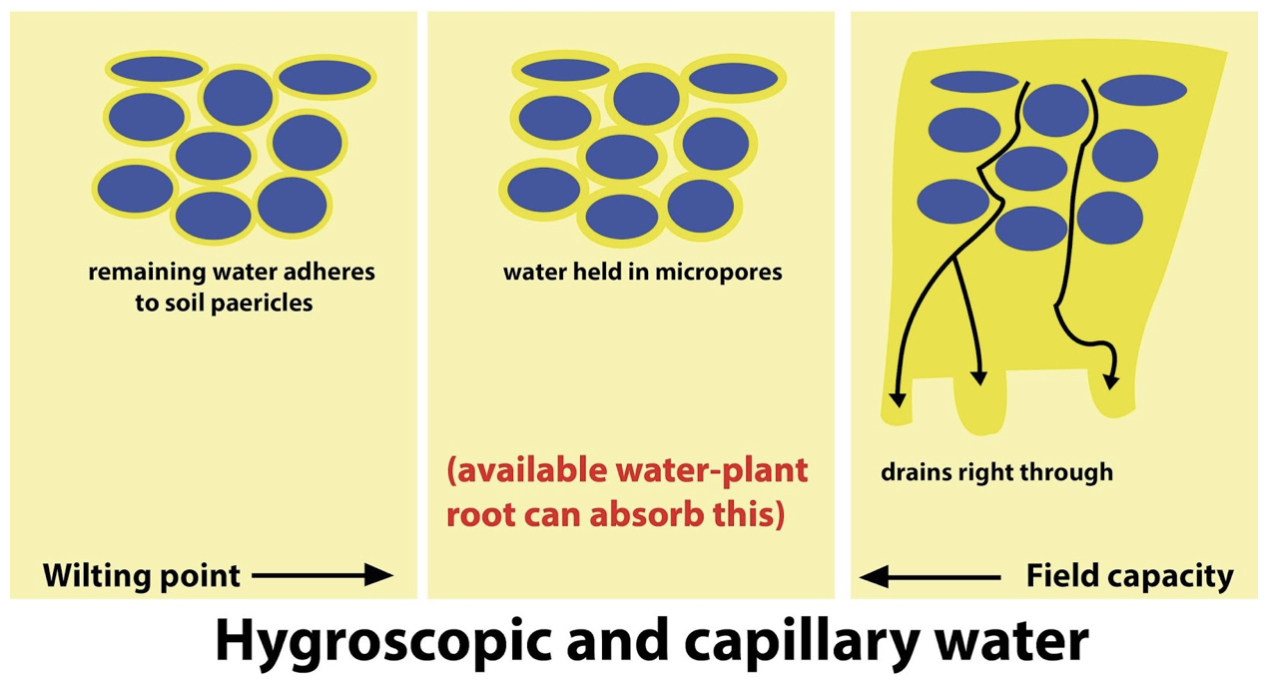
In a field capacity, the soil contains
(a) Capillary and gravitational water
(b) Capillary and runway water
(c) Hygroscopic and capillary water
(d) Hygroscopic, capillary water, and bound water
Answer
464.4k+ views
Hint: It is found as a microscopic film of water surrounding soil particles. This water is tightly bound to a soil particle by a molecular attraction so powerful that it cannot be removed by natural forces. This water can be eliminated via air drying or by plant retention, yet can't be taken out by gravity. With the help of the root, plants remove this water until the soil capillary force (force holding water to the particle) is equivalent to the extractive force of the plant root.
Complete answer:
The soil contains capillary, hygroscopic, and bound water at the field capacity. Due to the excessive water that exits or gets drained out from the soil after maximum absorption and runaway water is not associated with the field capacity. Capillary, hygroscopic and bound water is available in the soil so it tends to be remembered for field capacity.

Bound water is an incredibly thin layer of water encompassing mineral surfaces.
Hygroscopic water is the water that is tightly attached to the colloidal particle of the soil. It is inaccessible to the plants however present in the soil.
Against the pull of gravity, capillary water is held in the soil. Due to the cohesion force between the water molecules the water rises in the xylem.
Additional information: In the soil on the grounds, the capillary water is held and the surface tension properties (like cohesion and adhesion) of the soil micropores are very much stronger than the force of gravity. Hygroscopic water is present on the soil particles and not in the pores, specific kinds of soils with not many pores (clays for instance) will contain a higher percentage of it.
So, the correct answer is ‘Hygroscopic and capillary water’.
Note: When the soil dries out, the pore size increases and gravity starts to turn capillary water into gravitational water and it moves down. However, capillary water is the principal water that is accessible to plants as it is trapped in the soil solution directly close to the roots of the plant.
Complete answer:
The soil contains capillary, hygroscopic, and bound water at the field capacity. Due to the excessive water that exits or gets drained out from the soil after maximum absorption and runaway water is not associated with the field capacity. Capillary, hygroscopic and bound water is available in the soil so it tends to be remembered for field capacity.

Bound water is an incredibly thin layer of water encompassing mineral surfaces.
Hygroscopic water is the water that is tightly attached to the colloidal particle of the soil. It is inaccessible to the plants however present in the soil.
Against the pull of gravity, capillary water is held in the soil. Due to the cohesion force between the water molecules the water rises in the xylem.
Additional information: In the soil on the grounds, the capillary water is held and the surface tension properties (like cohesion and adhesion) of the soil micropores are very much stronger than the force of gravity. Hygroscopic water is present on the soil particles and not in the pores, specific kinds of soils with not many pores (clays for instance) will contain a higher percentage of it.
So, the correct answer is ‘Hygroscopic and capillary water’.
Note: When the soil dries out, the pore size increases and gravity starts to turn capillary water into gravitational water and it moves down. However, capillary water is the principal water that is accessible to plants as it is trapped in the soil solution directly close to the roots of the plant.
Recently Updated Pages
Master Class 12 Economics: Engaging Questions & Answers for Success

Master Class 12 Maths: Engaging Questions & Answers for Success

Master Class 12 Biology: Engaging Questions & Answers for Success

Master Class 12 Physics: Engaging Questions & Answers for Success

Master Class 12 Business Studies: Engaging Questions & Answers for Success

Master Class 12 English: Engaging Questions & Answers for Success

Trending doubts
Which are the Top 10 Largest Countries of the World?

Differentiate between homogeneous and heterogeneous class 12 chemistry CBSE

Draw a labelled sketch of the human eye class 12 physics CBSE

What is the Full Form of PVC, PET, HDPE, LDPE, PP and PS ?

What is a transformer Explain the principle construction class 12 physics CBSE

What are the major means of transport Explain each class 12 social science CBSE




